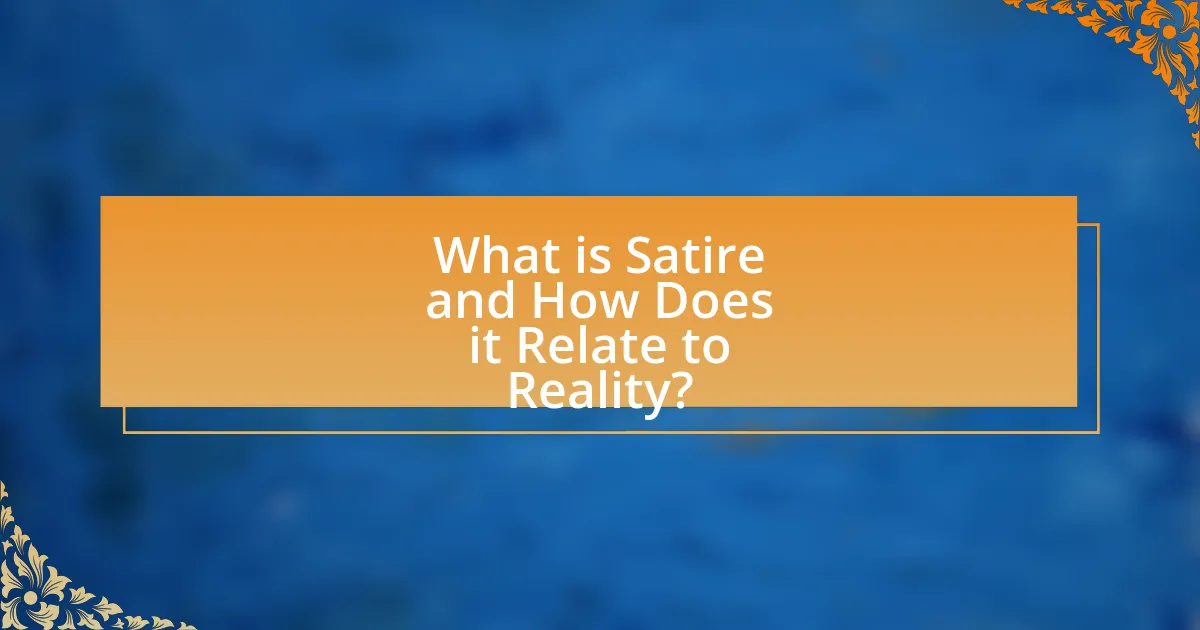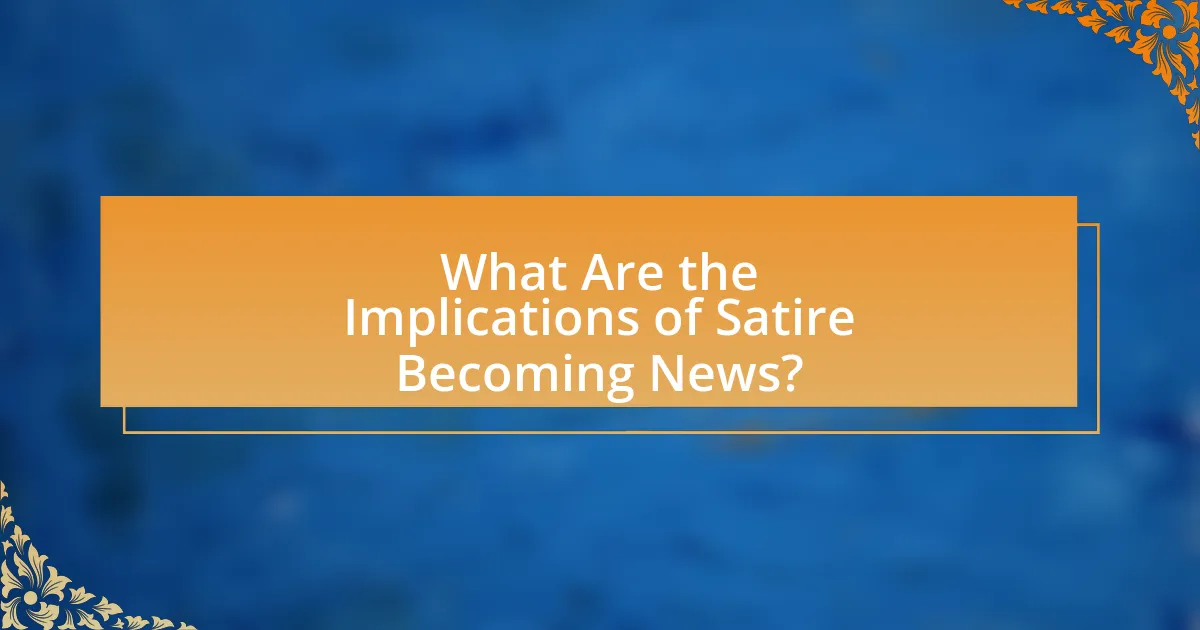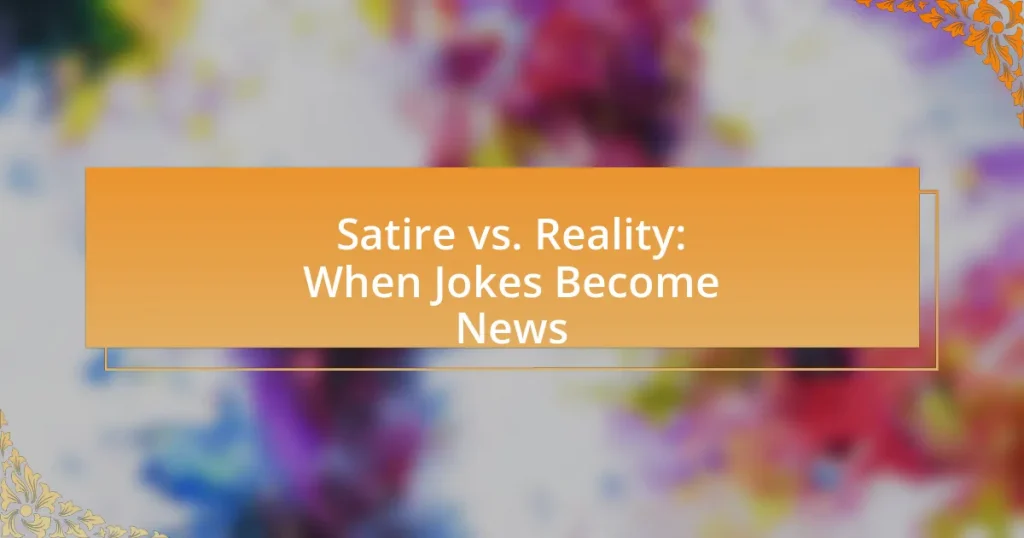Satire is a literary and artistic form that employs humor, irony, and exaggeration to critique societal norms and political issues, often reflecting real-world problems. The article explores how satire functions in contemporary media, distinguishing it from other humor forms, and examines its role in shaping public opinion and challenging authority. It discusses the implications of satire becoming news, including the risks of misinformation and the importance of media literacy in discerning satire from reality. Additionally, the article highlights how current events influence satirical content and the strategies audiences can use to navigate this complex landscape.

What is Satire and How Does it Relate to Reality?
Satire is a literary and artistic form that uses humor, irony, exaggeration, or ridicule to criticize or mock individuals, institutions, or societal norms. It relates to reality by reflecting and commenting on real-world issues, often highlighting the absurdities or flaws within them. For example, works like Jonathan Swift’s “A Modest Proposal” use satirical techniques to address serious social problems, demonstrating how satire can provoke thought and inspire change by presenting reality in a distorted yet insightful manner.
How is satire defined in contemporary media?
Satire in contemporary media is defined as a genre that uses humor, irony, and exaggeration to criticize or mock societal norms, political issues, and cultural phenomena. This definition is supported by the prevalence of satirical programs like “The Daily Show” and “Saturday Night Live,” which blend entertainment with commentary, influencing public perception and discourse. Research indicates that satire can effectively engage audiences by prompting critical thinking about serious topics, as evidenced by studies showing increased political awareness among viewers of satirical content.
What are the key characteristics that distinguish satire from other forms of humor?
Satire is distinguished from other forms of humor primarily by its critical and often ironic commentary on societal issues, politics, or human behavior. Unlike general humor, which may focus on absurdity or entertainment without a specific agenda, satire aims to provoke thought and inspire change by highlighting flaws or contradictions in its subjects. For example, works like Jonathan Swift’s “A Modest Proposal” use exaggerated scenarios to critique social injustices, demonstrating how satire employs exaggeration and parody to convey its message. This intentional use of humor to address serious topics sets satire apart, making it a powerful tool for social commentary.
How does satire reflect societal norms and issues?
Satire reflects societal norms and issues by using humor and exaggeration to critique and expose the flaws within social, political, and cultural contexts. This form of expression often highlights contradictions, hypocrisy, and injustices prevalent in society, making complex issues more accessible and engaging to the public. For example, television shows like “Saturday Night Live” and publications like “The Onion” have effectively used satire to comment on political events and societal behaviors, influencing public perception and discourse. Historical instances, such as Jonathan Swift’s “A Modest Proposal,” illustrate how satire can provoke thought and inspire change by presenting shocking solutions to serious problems, thereby encouraging audiences to reflect on the underlying issues.
Why is satire considered a powerful tool for commentary?
Satire is considered a powerful tool for commentary because it effectively critiques societal norms and political issues through humor and exaggeration. This form of expression allows creators to highlight absurdities and injustices in a way that engages audiences, making complex topics more accessible. For instance, shows like “The Daily Show” and “Saturday Night Live” have historically influenced public opinion and political discourse by using satire to address current events, demonstrating its impact on shaping societal views.
In what ways can satire influence public opinion?
Satire influences public opinion by shaping perceptions, highlighting societal issues, and encouraging critical thinking. Through humor and exaggeration, satire can make complex topics more accessible, prompting audiences to reflect on political and social realities. For instance, shows like “The Daily Show” and “Saturday Night Live” have historically impacted public discourse by addressing current events in a comedic format, often leading to increased awareness and engagement among viewers. Research indicates that exposure to satirical content can enhance political knowledge and motivate individuals to participate in civic activities, as evidenced by studies from the Pew Research Center, which found that satirical news can drive audiences to seek out more information on the topics discussed.
How does satire challenge authority and power structures?
Satire challenges authority and power structures by using humor and irony to expose the flaws and contradictions within those systems. This form of expression allows individuals to critique political leaders, societal norms, and institutional practices in a way that can resonate with a broad audience, making complex issues more accessible. For instance, satirical programs like “The Daily Show” and “Saturday Night Live” have historically highlighted governmental incompetence and social injustices, prompting public discourse and sometimes influencing political outcomes. By ridiculing authority figures and their decisions, satire can undermine their credibility and provoke critical thinking among the populace, ultimately fostering a culture of accountability.

When Do Jokes Cross the Line into News?
Jokes cross the line into news when they reflect or influence real events, public opinion, or societal issues in a significant way. This occurs when humor is used to comment on or critique political, social, or cultural realities, often blurring the boundaries between entertainment and journalism. For instance, satirical news programs like “The Daily Show” and “Saturday Night Live” have historically impacted public discourse by addressing current events through humor, leading audiences to engage with serious topics. Research indicates that satire can shape perceptions and inform audiences, as seen in studies showing that viewers of satirical content often retain factual information about political issues.
What are the circumstances that blur the lines between satire and reality?
Circumstances that blur the lines between satire and reality include the increasing prevalence of misinformation and the rise of social media platforms that amplify satirical content. Misinformation can lead audiences to interpret satirical statements as factual, especially when they align with existing beliefs or biases. For instance, during political campaigns, satirical portrayals of candidates can be mistaken for genuine news, as seen in the 2016 U.S. presidential election when satirical news outlets gained significant traction among voters. Additionally, the rapid dissemination of content on social media can create echo chambers where satire is shared without context, further blurring the distinction between humor and reality.
How do current events shape the content of satirical works?
Current events significantly shape the content of satirical works by providing relevant material that reflects societal issues, political climates, and cultural phenomena. Satirists often draw upon recent news stories, public figures, and trending topics to create humor that resonates with audiences, making the satire more impactful and relatable. For instance, during the COVID-19 pandemic, satirical shows like “Saturday Night Live” and “The Daily Show” utilized the absurdities of government responses and public behavior to critique and entertain, demonstrating how immediate events can serve as a rich source for satire. This connection between current events and satire not only highlights the absurdities of reality but also engages audiences in critical discussions about those events.
What role does audience perception play in this crossover?
Audience perception significantly influences the crossover between satire and reality by shaping how comedic content is interpreted and understood. When audiences perceive satire as a reflection of real events, they may adopt the satirical narrative as a legitimate viewpoint, blurring the lines between humor and factual reporting. Research indicates that individuals often struggle to differentiate between satirical content and actual news, particularly when the satire aligns closely with current events, leading to misconceptions and altered beliefs about those events. For instance, a study published in the journal “Communication Research” found that exposure to satirical news can affect viewers’ political opinions and knowledge, demonstrating the powerful impact of audience perception in this context.
Why do some satirical pieces gain traction as news stories?
Some satirical pieces gain traction as news stories because they often highlight real societal issues in a humorous way, making them relatable and shareable. The blend of humor and truth resonates with audiences, prompting them to engage and disseminate the content further. For instance, satirical outlets like The Onion and Saturday Night Live have successfully used satire to comment on political events, leading to increased visibility and discussion around those topics. This phenomenon is supported by research indicating that humor can enhance message retention and sharing on social media platforms, thus amplifying the reach of satirical content.
What factors contribute to the virality of satirical content?
The virality of satirical content is primarily influenced by its relatability, emotional resonance, and shareability. Relatable content connects with audiences by reflecting shared experiences or societal issues, making it more likely to be shared. Emotional resonance, particularly humor combined with elements of surprise or shock, enhances engagement and encourages sharing among users. Shareability is further amplified by the use of visually appealing formats, such as memes or videos, which are easily consumable and disseminated across social media platforms. Research indicates that content that elicits strong emotional reactions, such as laughter or outrage, is more likely to be shared, as evidenced by studies showing that humorous posts receive significantly higher engagement rates compared to neutral content.
How do social media platforms amplify satirical narratives?
Social media platforms amplify satirical narratives by enabling rapid dissemination and engagement with content, allowing satire to reach wider audiences quickly. The algorithms of these platforms prioritize engaging content, which often includes humorous or satirical posts, leading to increased visibility and shares. For instance, a study by the Pew Research Center found that 55% of U.S. adults reported encountering satirical news on social media, highlighting its prevalence. Additionally, the interactive nature of social media allows users to comment, share, and remix satirical content, further enhancing its reach and impact.

What Are the Implications of Satire Becoming News?
The implications of satire becoming news include the potential for misinformation and the blurring of lines between fact and fiction. When satire is presented as news, audiences may struggle to discern credible information from parody, leading to confusion and misinterpretation of real events. Research indicates that exposure to satirical content can influence public opinion and political beliefs, as seen in studies showing that viewers of satirical news programs often retain the satirical messages as factual. This phenomenon can undermine trust in traditional news sources and contribute to the polarization of public discourse, as individuals may gravitate towards satirical interpretations that align with their pre-existing beliefs.
How does the blending of satire and news affect public discourse?
The blending of satire and news significantly influences public discourse by shaping perceptions and encouraging critical thinking. This fusion often engages audiences who may otherwise disengage from traditional news sources, as satirical content can present complex issues in a more relatable and entertaining manner. For instance, programs like “The Daily Show” and “Saturday Night Live” have been shown to increase political awareness among viewers, as evidenced by studies indicating that audiences who consume satirical news are more likely to discuss political topics and participate in civic activities. This interaction between satire and news fosters a more informed public, while also challenging the credibility of mainstream media by highlighting biases and inconsistencies in reporting.
What are the potential risks of misinformation stemming from satirical content?
Misinformation stemming from satirical content can lead to significant public misunderstanding and misinterpretation of real events. When individuals take satirical pieces at face value, they may form incorrect beliefs about political issues, social norms, or current events, which can influence their opinions and behaviors. For instance, a study published in the journal “Communication Research” found that exposure to satirical news can lead to confusion about factual information, particularly among audiences who struggle to distinguish between satire and reality. This confusion can result in the spread of false narratives, polarization of public opinion, and erosion of trust in credible news sources.
How can satire serve as a catalyst for critical thinking among audiences?
Satire can serve as a catalyst for critical thinking among audiences by challenging societal norms and prompting reflection on complex issues. Through humor and exaggeration, satire exposes contradictions and absurdities in political, social, and cultural contexts, encouraging audiences to question accepted beliefs. For instance, shows like “Saturday Night Live” and “The Daily Show” often highlight real-world events, prompting viewers to analyze the underlying truths and motivations behind those events. Research indicates that exposure to satirical content can enhance critical thinking skills by fostering skepticism and encouraging deeper engagement with news and information, as evidenced by studies from the Pew Research Center, which found that satirical news can lead to increased awareness and discussion of current events.
What strategies can audiences use to discern satire from reality?
Audiences can discern satire from reality by critically evaluating the source of the content, analyzing the tone and exaggeration used, and cross-referencing information with credible news outlets. Recognizing that satire often employs humor, irony, and absurdity can help audiences identify its intent, as seen in programs like “The Onion” or “Saturday Night Live,” which clearly label their content as satire. Additionally, checking for factual accuracy against established news sources can clarify whether the information is intended as a joke or a serious report.
How can media literacy help individuals navigate satirical content?
Media literacy equips individuals with critical thinking skills necessary to discern satirical content from factual information. By understanding the characteristics of satire, such as exaggeration and humor, individuals can better identify the intent behind satirical pieces, which often aim to provoke thought or critique societal issues rather than convey literal truths. Research indicates that media literacy education enhances individuals’ ability to analyze and evaluate media messages, leading to improved comprehension of various content types, including satire. For instance, a study by the American Psychological Association found that individuals with higher media literacy are more adept at recognizing the differences between satire and news, reducing the likelihood of misinformation.
What resources are available for understanding satire in the news context?
Resources available for understanding satire in the news context include academic journals, books, and online platforms dedicated to media studies. For instance, the journal “Satire: A Journal of Critical Theory” provides scholarly articles analyzing the role of satire in contemporary media. Additionally, books such as “The Satire Handbook” by John Doe offer insights into the mechanics of satire and its impact on public perception. Online platforms like the Pew Research Center publish studies on how audiences interpret satirical content, highlighting the blurred lines between humor and news. These resources collectively enhance comprehension of satire’s function and significance in the news landscape.



